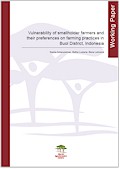| Working Paper Series |
 |
|
| Title | Vulnerability of smallholder farmers and their preferences on farming practices in Buol District, Indonesia | | Author | Sacha Amaruzaman, Betha Lusiana and Beria Leimona | | Year | 2015 | | Publisher | World Agroforestry Centre (ICRAF) Southeast Asia Regional Program | | City of Publication | Bogor, Indonesia | | Series Number | Working Paper no. 213 | | Number of Pages | 27 | | Call Number | WP0192-16 | | Keywords | Vulnerability, shocks and hazards, trees and crops, criteria, smallholders’ preferences |
|
| Abstract: |
The majority of residents of Buol District in Central Sulawesi Province in Indonesia depend on
farming for their livelihoods. Similar to those in other poor districts in Indonesia, the smallholders in
Buol are vulnerable to hazards and shocks, whether related to climate or socio-economic-political
changes. Programs are carried out by the government and development agencies to improve the
smallholders’ resilience to those shocks and hazards.
This paper analyses vulnerability perceptions of female and male smallholders in Buol. The analysis
of vulnerability includes productivity fluctuation of commodities and the shocks, exposure, response
and impact smallholders experience with extreme events. Further, to see the potential of increasing
smallholders’ resilience through agricultural activity, the paper discusses smallholders’ criteria for
selecting tree and crops, and actual preferences for tree and crop species based on those criteria.
The study was conducted in three cluster sites of the Climate-smart, Tree-based, Co-investment in
Adaptation and Mitigation in Asia (Smart Tree-Invest) project in Buol District, Central Sulawesi,
Indonesia. The vulnerability assessment was conducted using a focus-group discussion approach
while preferences for trees and crops were analysed using the Analytical Hierarchical Methodology
(AHP).
The community in the upstream cluster stated that water scarcity was one of the main problems owing
to unavailability of a technical irrigation system in their area, thus, they were highly dependent on
rainfall. In the midstream cluster, the community perceived floods as their main problem, which
began after dam construction that altered the direction of river flow. The smallholders in the coastal
zone faced the threat of coastal abrasion owing to mangrove degradation. Regarding productivity
fluctuation, coconut productivity was the most resilient during extreme events while cacao was
perceived as the most vulnerable commodity because its productivity tended to fluctuate during years
with extreme events.
The top three priority criteria for selection of trees and crops were land suitability; household income;
and ease of maintenance. These were selected by all groups across all clusters. The five main
commodities prioritized by farmers in all clusters were cacao, coconut, rice, clove and coffee.
For each agricultural problem identified, smallholders had already undertaken actions and were
considering other potential solutions. Recognizing these major problems and the ideal responses
perceived by farmers is essential for providing effective solutions to improve farmers’ resilience in
these clusters. |
|